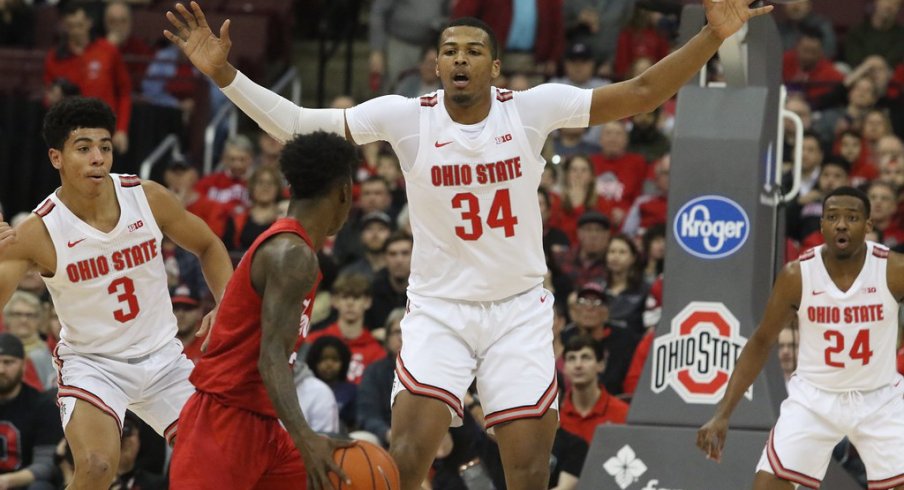Despite Sunday's loss in East Lansing, the Ohio State basketball team remains a top-10 team.
You're probably wondering how I could possibly be confusing the 19th spot in the AP poll as being inside the top ten, or why I'm not just writing about football like usual. I can't blame you for either point. But with Chris Holtmann's team entering postseason play, now seems as good a time as any to examine how they've maintained the eighth spot in the KenPom ratings despite an up-and-down, 21-10 record.
Though the Buckeyes have been above-average in a number of the areas that factor into Ken Pomeroy's algorithm, their ability to stop opposing two-point field goals has been among the nations' best this season. Opponents have shot just 44.2% inside the arc, a full 5% lower than the Division-1 average of 49.4%
While much has been made of the Buckeyes' struggles to stop three-pointers from raining down, at one point ranking last in the conference in opposing 3-pt percentage, it seems to have been a conscious decision from Holtmann to allow for such a tradeoff. Clearly, the OSU staff believes their best chance to win is by the betting that opponents won't get hot enough from outside to keep pace with his team's own shooting prowess.
Additionally, the personnel at hand allows the Buckeyes to employ one of the riskier defensive tactics available.
With the absences of Kyle Young and DJ Carton, Ohio State's rotation has shrunk considerably. It's left just one true big man in Kaleb Wesson (who isn't known for his lateral quickness), but with a slew of maturing guards, the Buckeyes have chosen for a team-first defense of the pick-and-roll which is not often seen at the major college level.
There are many ways to defend high ball-screens (coach-speak for the 'pick-and-roll' you might run in your weekly pickup game), as this action is the most common way offenses initiate their attack in the modern game. Not only does it create space for a lead ball-handler to turn the corner, but it forces defenders to think quickly and communicate.
Though many of us think of such plays as attacking only the two defenders whose assignments are involved, it takes all five players on the floor to properly defend when the Buckeyes employ their "blitz."
In essence, the blitz is a miniature trap, as the two defenders closest to the ball will both stay on the dribbler, looking to contain it rather than force a steal. Often, this incites panic in younger ball-handlers, and they quickly pick up their dribble.
But the dribbler's first option - the man who set the screen and is rolling to the rim - is defended by the remaining three defenders off the ball, who have eased off their men and drop to a makeshift zone look behind the blitz. Those three players hedge between their original assignment and the roller, keeping their eyes on the ball at all times and forcing it to the least dangerous spots on the floor.
Once the dribbler does pick up his dribble, however, the defense snaps back into a man-to-man look. The big man who had the screener will sprint back from the ball to find his man in the paint while the help defenders close out on the wings.
The result is often a contested shot from someone who didn't expect the ball to be in their hands on that possession in the first place.
This is not to say the blitz is fool-proof, however. There are obvious risks. Even if it's just for a moment, the double-team on the ball always leaves someone open, and conference opponents have tried to exploit this weakness.
In their matchup last week, Illinois' first points of the game came off a high screen which resulted in an easy three.
Dribbler Ayo Dosunmu used off the screen and went toward the wing, rather than the paint, and found his nearest teammate wide open after Andre Wesson dropped to help defend the roller. The action caught the Buckeyes by surprise, as rarely does a right-handed ball-handler dribble into the right sideline with into another teammate standing there, but the Illini had done their homework.
Yet despite the occasional open look, opponents are only shooting just 32.7% from deep this season, which is still below the national average of 33.3%. More importantly, though, the style may prove incredibly effective as the team enters tournament play.
With often only a day or two to prepare, many of the Buckeyes' remaining opponents may struggle to create the open looks seen from the Illini above, assuming they even have enough shooters to knock down those shots to begin with. Meanwhile, Ohio State can bank on seeing a high pick-and-roll in every remaining game, and their go-to defense shouldn't need to change.
If an opponent has the kind of playmaker who can simply beat defenders without a screen, the way Cassius Winston did yesterday for the Spartans, so be it. Players like that are few and far between at the college level. But so is a blitzing defense that can fluster ball-handlers and take away the paint so effectively.


